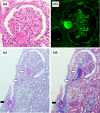A case of lupus vasculopathy presenting favorable renal outcome
- PMID: 31863345
- PMCID: PMC6990287
- DOI: 10.1007/s13730-019-00431-2
A case of lupus vasculopathy presenting favorable renal outcome
Abstract
Noninflammatory necrotizing vasculopathy, also referred to as lupus vasculopathy, is not infrequently observed in the pathology of lupus nephritis. It affects vessels causing them to become severely narrowed and occluded by a mechanism involving immune complexes. We experienced a 51-year-old woman with lupus nephritis class IV + V, which was accompanied by lupus vasculopathy. Renal biopsy and light microscopy showed eosinophilic hyaline-like material in the afferent and/or efferent arterioles, which narrowed the lumen, and which were positive for IgG by immunofluorescent analysis. Electron microscopy indicated that amorphous material and endothelial detachment occluded the arterioles. These findings were consistent with those of lupus vasculopathy. We treated the patient with steroids and cyclophosphamide. By the day of discharge, her levels of creatinine and proteinuria had undergone partial remission. Although lupus vasculopathy was implied as a lesion with unfavorable renal prognosis, some recent reports suggest its true renal prognosis is not unfavorable necessarily. Nevertheless, lupus vasculopathy is an important finding in diagnosis in contradiction to other vascular legions in systemic lupus erythematosus. In addition, a standard therapy has also not been established. Therefore, it is important to accumulate cases of lupus vasculopathy to determine its prognosis and develop standard treatments.
Keywords: Lupus nephritis; Lupus vasculopathy; Noninflammatory necrotizing vasculopathy.
Conflict of interest statement
The authors have declared that no conflict of interest exists.
Figures



Similar articles
-
Renal infarction due to lupus vasculopathy.Lupus. 2015 Aug;24(9):985-9. doi: 10.1177/0961203315570684. Epub 2015 Feb 6. Lupus. 2015. PMID: 25661836
-
Lupus vasculopathy combined with acute renal failure in lupus nephritis.Pediatr Nephrol. 2003 Dec;18(12):1304-7. doi: 10.1007/s00467-003-1266-2. Epub 2003 Oct 24. Pediatr Nephrol. 2003. PMID: 14579140
-
Lupus vasculopathy combined with renal infarction: unusual manifestation of lupus nephritis.Intern Med. 2005 Nov;44(11):1185-90. doi: 10.2169/internalmedicine.44.1185. Intern Med. 2005. PMID: 16357459
-
[Treatment of lupus nephritis in children].Arch Pediatr. 1999 Dec;6(12):1312-21. doi: 10.1016/s0929-693x(00)88895-8. Arch Pediatr. 1999. PMID: 10627904 Review. French.
-
Kidney disease in systemic lupus erythematosus.Rheumatol Int. 1991;11(3):113-5. doi: 10.1007/BF00304498. Rheumatol Int. 1991. PMID: 1754812 Review.
Cited by
-
Modified arteriosclerosis score predicts the outcomes of diabetic kidney disease.BMC Nephrol. 2021 Aug 18;22(1):281. doi: 10.1186/s12882-021-02492-x. BMC Nephrol. 2021. PMID: 34407751 Free PMC article.
References
-
- Klemperer P, Pollack AD, Baehr G. Pathology of disseminated lupus erythematous. Arch Pathol. 1941;32:569–631.
-
- Appel GB, Pirani CL, D’Agati V. Renal vascular complications of systemic lupus erythematosus. J Am Soc Nephrol. 1994;4(8):1499–1515. - PubMed
-
- Banfi G, Bertani T, Boeri V, Faraggiana T, Mazzucco G, Monga G, et al. Renal vascular lesions as a marker of poor prognosis in patients with lupus nephritis: Gruppo Italiano per lo Studio della Nefrite Lupica (GISNEL) Am J Kidney Dis. 1991;18(2):240–248. doi: 10.1016/S0272-6386(12)80885-7. - DOI - PubMed
Publication types
MeSH terms
Substances
LinkOut - more resources
Full Text Sources
Medical

